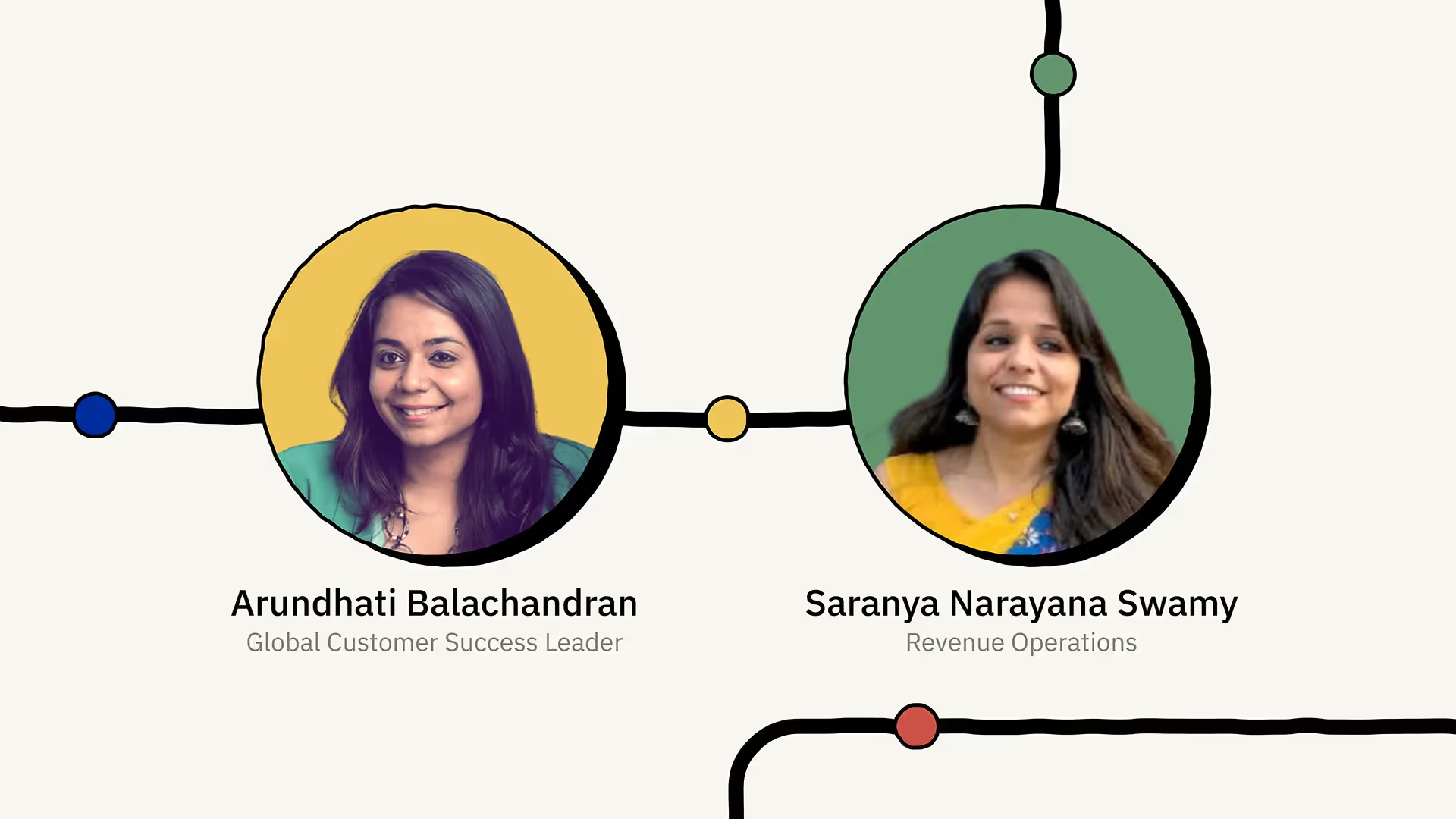The expansion of Customer Success in terms of scope led to new roles with specializations such as Customer Success Operations (CS Ops).
CSMs or even CXOs cover this function at early-stage startups, but as the company scales and the CS teams mature, having a separate operations role or team will be evermore essential and prevalent.
At Rocketlane, we want to actively help out organizations trying to build this function by interviewing folks in CS Ops and bringing out their stories of successful transitions into CS Ops.
For the second installment of this series of interviews, we spoke to Arundhati, Global CS Leader, and Saranya, Revenue Ops Lead at Chargebee. They talk about the importance of data, tools, and processes in the CS Ops function that helps companies to scale up.
Here’s the conversation between them and Sri, co-founder, Rocketlane.
. . .
Sri: Hi Arundhati and Saranya, thanks for joining me. It’s exciting to have you both here and talk more about CS Ops. Tell me about your roles at Chargebee.
Arundhati: Sure! I’m leading a 40-member CS team now. I took over the CS team at Chargebee in early 2019 when we were just three people, and I think we will be 50 by the end of this year.
Saranya: I have been with Chargebee for three years now, and I started as an NPS specialist. I moved to the CS Ops role in early 2019, and now I’m a part of the RevOps team catering to Sales, Pre-sales, Partnerships, and CS teams.
Sri: Awesome! I’ll start with Saranya. Tell us how it felt when you moved from Customer Success to Customer Success Operations?
Saranya: Yeah. I started as an NPS specialist, and my core role was to make sure that the customer's issues were answered and the NPS increases as we progress. Arundhati saw an NPS analysis of mine and asked me if I’d be interested in analyzing Customer Success as a whole and not just NPS.
I was a novice. Because, firstly, I didn’t have a sales background. Secondly, Customer Success was a completely new area for me. But I thought of giving it a shot, and I haven’t looked back. It's been an amazing journey.
This also happened when the team was small, and we were building an in-house tool while figuring out the metrics that we wanted to track. So all of us were learning and trying to figure out things. We did a lot of experimentation, and I had constant support.
I am learning a lot more about pre-sales, customer success, partnerships, and how all of them work together.
Sri: What's the one point that tipped your decision to move over to CS Ops?
Saranya: I like exploring new things, playing with data sets on Google Sheets, and automating stuff. Then there’s customer success with multiple responsibilities such as pre-sales, onboarding, handling customer relationships, measuring metrics, etc. I get to use various tools, set up automation, measure team efficiency, and all of that. Honestly, I just went with the flow.
Sri: Arundhati, how did the whole idea of setting up a CS Ops team for Chargebee come about? When was the need felt, and how did you go about setting up a CS Ops team?
Arundhati: When I took over the team, we had three targets: expansion, retention, and advocacy. The first thing that we prioritized was retention, followed by expansion and then advocacy. A month into my role, I looked through onboarding data, and we saw more churn in the early customer life cycle.
I also wanted to know how long it takes for a customer to get on board and when they go live. So I reached out to Saranya for help on automating Excel stuff. And it started as a crazy formula on Excel, which I couldn't figure out. But Saranya did it within five minutes, which I took two hours to do.
We weren't looking to create a CS Ops team. But there was a lot of data analysis to be done in a short time. So, the first exercise I gave to Saranya is to segment customers by their size and calculate the duration of time-to-value. And she did a fabulous job. Her second exercise was to plan capacity for us to understand how many people to hire for our team.
We realized the importance of these tasks every day, and I needed her to ensure that we were using data to figure out strategies for CS. And that’s how our CS Ops team started. We also implemented ChurnZero around the same time. So, we had to automate engagement for SMB customers and created a high-touch model for enterprise customers.
Sri: So, what were you looking for when you made your first few hires from a CSM or CS Ops standpoint?
Arundhati: So when we made the first few hires, we wanted to ensure that the Customer Success tool was ready because the first important thing is to have a 360° degree view of the customer. So Saranya set up the automation tools for the team. We use Fresh Sales for CRM, Freshdesk for helpdesk, and ChurnZero for Customer Success.
Apart from reporting and data analysis, we had to build a framework for CS Ops to automate the playbooks for CSMs. So, by setting up these frameworks and implementing them using Churnzero, we could detect the early signs of risk, such as customers not using the product, customers raising a lot of support tickets, especially high-priority ones. This helped us to identify and understand who could be a high-risk customer proactively.
Sri: You mentioned that you were looking at onboarding data to understand churn. Was there any specific process that decreased churn from the onboarding perspective?
Arundhati: Absolutely. This started in early 2019, and the story’s ongoing. Our churn rate at that time was 3.5%. To reduce this, the first thing we did was to set up rules of engagement among the three teams involved—starting from handoff from Sales to Onboarding to Customer Success & Ops team—so that there is a smooth transition from one lifecycle stage to the next for the customer. If you have too many players in the mix, customers don't know their point of contact at your organization. So, we wanted to make sure that we had the lifecycle stages clearly defined and allocated owners based on that lifecycle. Secondly, there’s an ongoing churn SWAT within Chargebee where all the GTM owners, such as the Head of Sales, Pre-sales, Implementation, Customer Success, Product, and CS Ops teams, come together to bubble up all high-risk customers. We do this using health scores and qualitative data from the CSM or the implementation consultant. Then we check the accuracy of data, keep tweaking the health scores to ensure we try to bring every customer to a healthy score. So, this three-step process has helped us over time, and our churn rate is below 1%.
Sri: Okay, that's a lot of insight. Now over to Saranya. Tell us what skills you need to get into CS Ops?
Saranya: Okay, I'll start with three things that a CS Ops person should know: tools, data, and process. I’ll start with tools. I think it's very important to be open to understanding what the tool does. Because, if you’re like me who didn’t have background or experience in this, then it’ll be slightly confusing on integrating the tools, understanding the data flow, how to get more data and insights to make our lives easier, etc.
So, it’s important to understand what tools you want to use, what kind of integrations it can do, what tools you’re already using, and whether they’re compatible. Also, check if the UI is good enough for the team to adapt and what insights or value it will add. But before getting the tools, make sure you understand the requirements of the CS team so you can get the right tool.
Coming to data, you need to have a very deep knowledge of Excel. Because you won't just measure your team’s performance, but you’ll keep track of your customer too, which is huge. Also, you need to know how to handle Data Studio, integrate it with Google Sheets, and create live dashboards there. For analyzing the data, you need to focus on a few key things, such as customer usage of the product, KPIs to track, insights on what factors drive customer satisfaction and churn, etc.
Lastly, you need to be hands-on in terms of process and know what’s happening in the team and customers. You need to understand your CSMs’ issues, what’s working for them and what’s not, how you will address it through analysis, etc. Based on this, you need to coordinate with other teams and the leadership to change the process.
Sri: Okay, so what advice would you give to someone who wants to get into Customer Success Ops as a fresher or someone who wants to transition from another function?
Arundhati: Anybody who wants to join CS Ops must love playing with data and figuring out insights. Also, I think it’s better to have a customer-facing experience because they have a better understanding of the CS function, what's required of a CSM, with a sole focus on Customer Experience. This will intuitively help them set those playbooks and automation in place. Also, it’s good to have SaaS experience, but it’s not necessary.
The other thing I would point out is that from an Ops standpoint, there are three distinct roles that you need to know: tools, data & reporting, and team performance & compensation. You don't need to know all three, but you need to know which one you’d like to do. Over to Saranya.
Saranya: I think Arundhati pretty much covered everything. I’d like to add that not one person can do all of those three things. So, it’s better to specialize in one particular area and then build on top of it. But, always be curious to learn everything, filter out things you don’t like, and get your hands dirty. So I think the attitude to learn and be curious is very important. And I think that's helped me a lot.
Sri: Okay, this brings me to the next question: What would your argument for establishing a CS Ops function in your customer’s organization be?
Arundhati: I've had these conversations with our founders, and I look at it as customer success metrics feeding into organization-level metrics. When you look at NRR, it determines how profitable your business is. And that's the #1 metric your investors want to know. So I think CS Ops is crucial to have all your org-level metrics in one place, and you can prepare for board meetings with this data. Of course, the finance team does have a good understanding of these metrics, but I can tell you with experience that Finance needs to work closely with CS Ops to understand the health of our customers and the customer base.
I usually have a minimum of 2-3 conversations with Saranya every day to understand which customer segment is growing, our high-risk customers, which industry is growing during the pandemic, and create an expansion playbook for them. If a particular customer/industry isn’t doing well, we make sure we have some very strong retention playbooks in place for them. And we were able to achieve that 1% churn rate even during the pandemic because we were proactive from a CS Ops perspective. So I think these are enough reasons to know why you need a CS Ops team in a SaaS business.
Sri: How do you see the evolution of CS Ops function in a company?
Arundhati: As the company scales, you will look to centralize CS Ops with RevOps. But there are still dedicated people for CS Ops, right from MQLs to renewals. You need different Ops players focusing on different teams upstream to downstream. From a career path standpoint, you could grow into a Chief of Staff for a founder because CS Ops people understand data and metrics. Every founder needs that person to rely on to strategize, and data-driven strategies are key to success.
Sri: Any lessons from working in the CS Ops space that you would apply to life?
Saranya: I think many skills I've developed like coordination, prioritizing, time management, and switching between tasks are very important, especially when you handle so many things.
I have to agree that I struggled during the initial days because we were approaching too many things, and I felt a little overwhelmed. But then we came up with something called the ‘Top Three Things For The Week’ to focus on the important ones.
Also, when you’re in CS Ops, try to help the finance or sales teams, or become their go-to person, because honestly, that’ll make you feel good about something.
Arundhati: What I've learned, working alongside Saranya, is that firstly, it’s exciting to learn something new. I think the confidence that you get after experimenting with something new and seeing it mold into a team is awesome. And with that confidence, I feel like I can conquer anything in life. Secondly, if you're data-driven, you can be good at anything.
And I have played a multifunctional role in the GTM space for 18 years of my work experience. This role lets me do different things on a day-to-day basis with a lot of data. So I think that part of it is the confidence to know that you can do solid stuff with data. And it's not rocket science. It's just something you need to practice. So, these are my life lessons from CS Ops.
Sri: So get better at Excel, be data-driven, prioritize the top three things per week.
Arundhati: Yeah. One of the things that Saranya has been focusing on for the last two years is forecasting churn. We've now solved for predicting churn on a weekly/ monthly/annual basis by building multiple models, which has been a huge learning experience for both of us.
Saranya: Yeah. I think we did an exercise of setting our goals for 2021. We brainstormed on churn, modeling, expansion, etc. And then, we figured out what can be a reasonable goal for Customer Success. Usually, it's top-down, but this time we did the opposite.
Sri: So you had conversations with everyone on the team to figure out what they want to do?
Saranya: Yes, I went completely with a data-driven model based on historical data because only in 2019, we built the CS team. So, based on data, we did forecasting, and then we had a lot of 1:1 conversations with our vendor to go through that model and see if it’s okay, because again, numbers can also give you some random data. We all did a lot of brainstorming on that, and then we came up with what we thought would be an ideal yet realistic goal for 2021. So that's how we approached it.
Sri: You set the CS Ops team in 2019, right? So how did the pandemic affect this function?
Saranya: Actually, for the first few months, I just went crazy because we were doing many initiatives for our customers.
And a lot of them were affected by COVID. So, we proactively helped them to make sure that their business holds on for this time period. These initiatives had a lot of dependency on Ops, like setting up campaigns, giving them credits, features for free of cost to increase the revenue, etc.
This was very hard because when you're in an office, you just have to turn to your team and tell them what to do. But virtually, you have to message, get everyone on calls, especially so many calls. So yeah, it was difficult. But now, we know what to do. And we're a bit more organized and sorted as a team.
Arundhati: Yeah, I think the pandemic was a crucial game-changer for us because that determined which customers are going into our expansion playbook and which went into our retention playbooks.
Sri: So, were there any new processes you set up for remote working to help with productivity and consistency?
Arundhati: As an organization, we already had flexible work from home policy even before the pandemic hit us. Chargebee’s culture is very open. Of course, we implemented a few changes when the entire org went remote, like setting up more meetings to ensure that we are communicating consistently, etc. The processes and KPIs are also set up to incentivize the right behavior aligned with the organization’s priorities. There is less need to “manage” the team, and the focus is on enabling them with the right tools to achieve their goals.
If they need any support, we are there to help them. And we are happy with the progress we have made with this setup.
Sri: Right. What are you looking forward to in 2021 in your professional life?
Arundhati: 2019 and 2020 was about getting our processes and framework for retention and expansion revenue in place. Many people don't think Customer Success is a revenue generator and an integral part of the revenue org. But having said that, we should not forget customer experience, right? We are thinking about leveraging data to deliver the best experience we can to our customers. So our priority for 2021 is going back to what Saranya was doing earlier—NPS and figuring out customer sentiment. Also, calculating how many advocates we have at Chargebee and how we can keep increasing champions and advocates. And if we can ace that, then we would be a formidable CS function.
Saranya: For me, it’s two things I want to focus on: getting better at predictability forecasting and giving more actionable insights to the sales and the customer experience teams, which will have a direct impact on revenue.

























.webp)